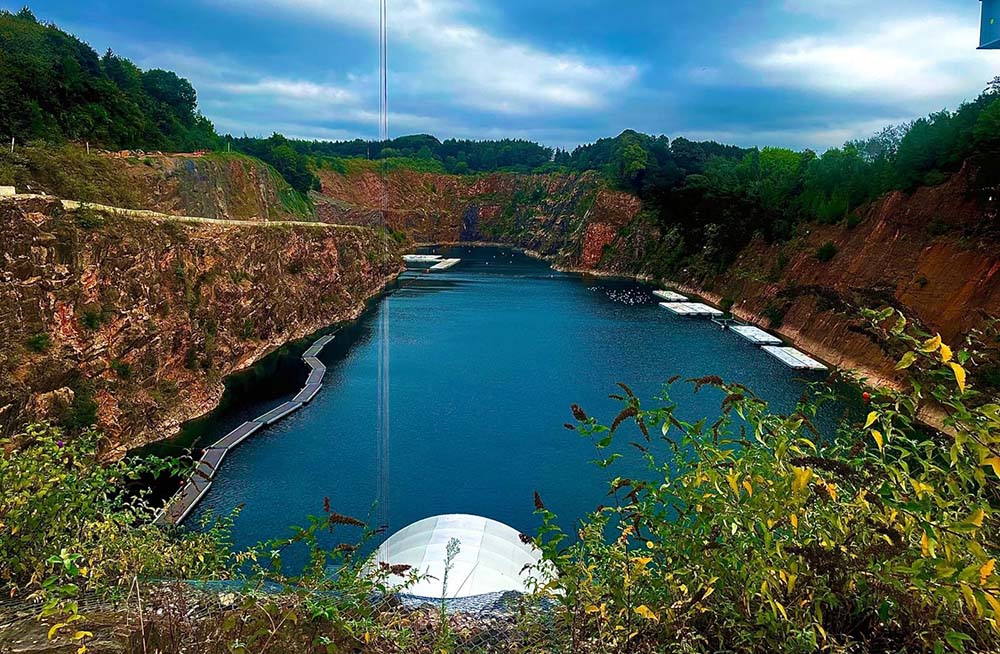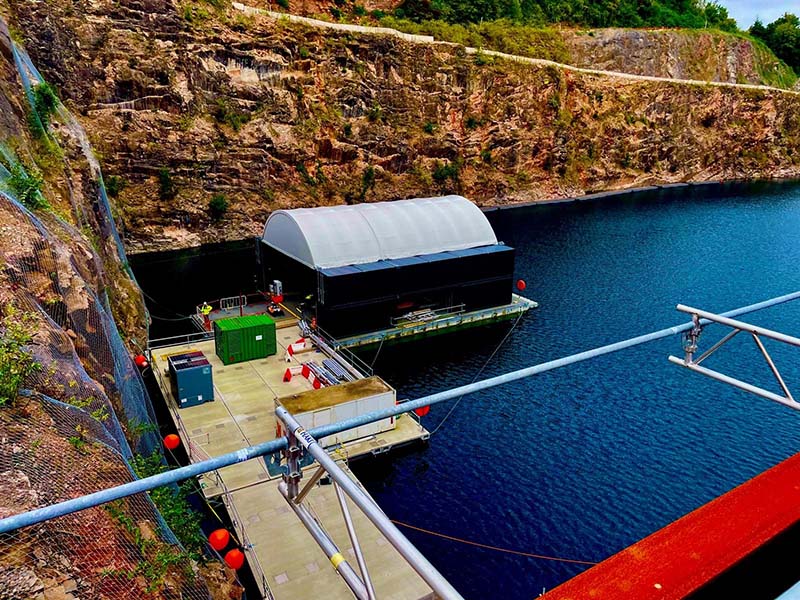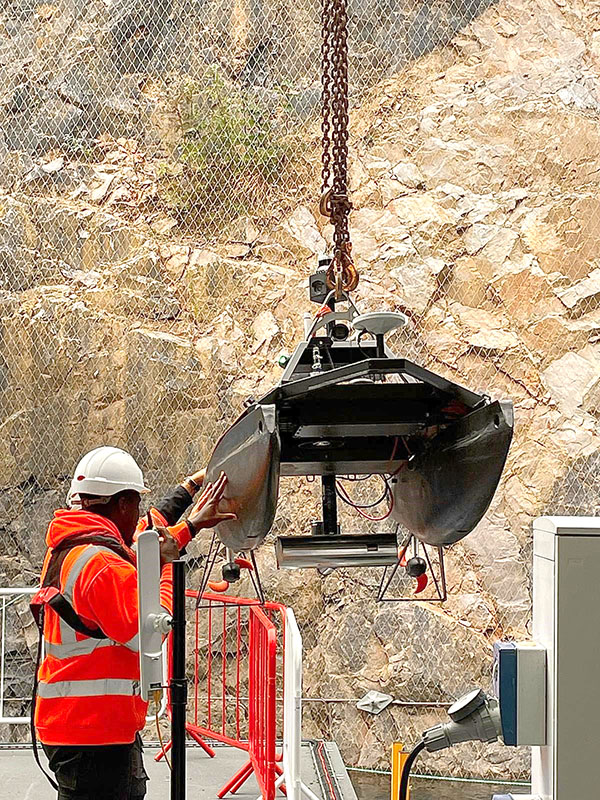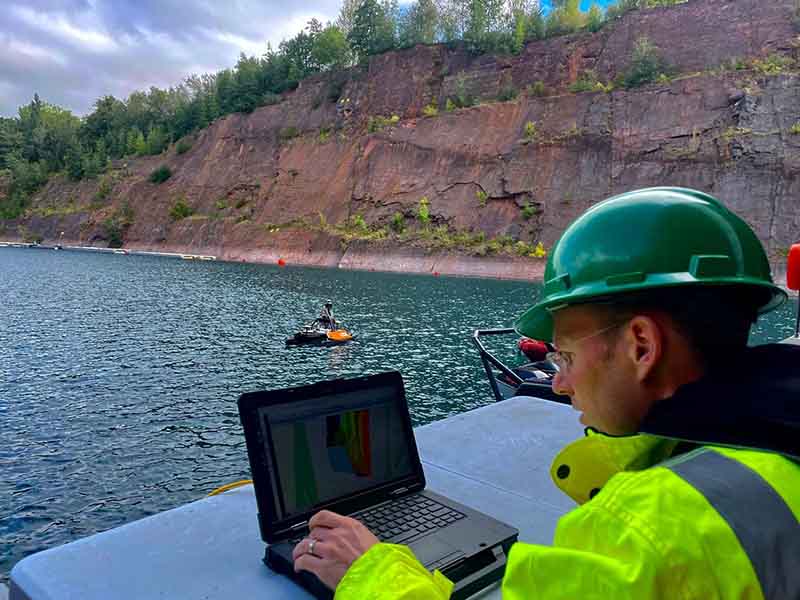
Recently, Teledyne Marine joined forces with Maritime Robotics and DEEP to survey DEEP’s quarry lake, affectionately referred to as Loch Lyr, a unique site in the Wye Valley.
Loch Lyr serves as the centrepiece of DEEP Campus, a cutting-edge facility developed by the visionary company DEEP, whose mission is to “make humans aquatic.”
Spanning 50 acres, this former National Dive Center offers an unparalleled environment for testing subsea equipment, developing methodologies, and training personnel in controlled conditions. The loch itself stretches 500 meters in length, up to 125 meters in width, and plunges to an impressive 80 meters of depth. Its water quality is pristine, maintained by innovative measures such as perimeter curtains designed to limit debris from entering.
Watch a mini documentary about the survey of the 80-meter-deep lake
Inside Deep Campus

Upon arrival, the team underwent rigorous security protocols, site safety briefings, and was equipped with appropriate PPE. From the top of the site, the full extent of the water was hidden from view, with access options limited to a 10-story scaffold staircase or a ride in the site’s crane.
Operations were based at the floating ’Subs Island’, situated just below the crane. To safeguard the loch’s exceptional water quality, only electric vessels are permitted to operate.
Surveying with Advanced Technology
 The team deployed the latest survey equipment, including a
Teledyne RESON SeaBat T51 (800 kHz) multibeam sonar with integrated inertial navigation, paired with a Teledyne Valeport SWiFT profiler. Mounted on a Maritime Robotics Otter Pro vessel, these technologies represent the forefront of hydrographic mapping.
The team deployed the latest survey equipment, including a
Teledyne RESON SeaBat T51 (800 kHz) multibeam sonar with integrated inertial navigation, paired with a Teledyne Valeport SWiFT profiler. Mounted on a Maritime Robotics Otter Pro vessel, these technologies represent the forefront of hydrographic mapping.
The
SeaBat T51’s controls were tailored for autonomous operations to map the quarry, while the SWiFT profiler complemented the system by providing critical environmental data – such as temperature, sound velocity, and depth – to correct multibeam readings. An onboard winch enabled remote deployment, and near real-time profiler data was accessible via smartphone for immediate quality control.
 The electric Otter Pro vessel, launched via crane, operated seamlessly both locally and remotely. During surveyor breaks, operators in Norway controlled the vessel through satellite communications, leveraging its onboard cameras and collision avoidance radar to navigate autonomously with precision. The survey produced high-quality data, covering nearly the entire body of water in a single pass.
The electric Otter Pro vessel, launched via crane, operated seamlessly both locally and remotely. During surveyor breaks, operators in Norway controlled the vessel through satellite communications, leveraging its onboard cameras and collision avoidance radar to navigate autonomously with precision. The survey produced high-quality data, covering nearly the entire body of water in a single pass.
DEEP’s Vision: Permanent Underwater Human Habitats
DEEP’s aspirations extend far beyond surveying. Their flagship product, Sentinel, is a modular subsea habitat capable of sustaining human life and operations at depths of 200 meters for up to a month. These habitats could be the underwater equivalent of the International Space Station, enabling a permanent human presence beneath the ocean surface.
Applications for Sentinel range from ocean research to the excavation of historical shipwrecks. These habitats are being built using Wire Arc Additive Manufacturing (WAAM) – a state-of-the-art 3D printing process that uses an electric arc to melt a metal wire feedstock. WAAM enables the rapid production of complex, large-scale structures (up to 6.2 diameter x 3.2 meters) with exceptional quality.
A
Collaborative Success
The Loch Lyr survey highlighted the capabilities of Teledyne Marine and Maritime Robotics in real-world conditions, delivering invaluable high-quality data to support DEEP’s initiatives. This data will play a critical role in identifying ideal locations for Sentinel habitats and informing the operational plans of DEEP’s dive teams.
Sean Wolpert, President of DEEP, expressed his appreciation for the collaboration and the exceptional results achieved:
“We’ve been very impressed with the quality of the data provided. With the work that Teledyne has accomplished for us we have gained granular, high-resolution imagery that will allow us to determine where we will place our first habitats for testing in the quarry. Having a detailed view of the surrounding areas will help us inform our dive teams, making sure safe and effective dive programs are in place.”
Special thanks to the DEEP Campus team for their hospitality and use of this extraordinary site. Such collaborations allow Teledyne Marine to test products in practical scenarios, ensuring they deliver the best possible solutions to customers.
DEEP represents a bold leap forward in underwater exploration and technology. This successful survey underscores the power of collaboration and innovation in advancing our understanding of the underwater world.
Learn more about DEEP 🡥
